Taxation Law
VerifiedAdded on 2023/03/31
|13
|2799
|222
AI Summary
Get expert assistance on taxation law assignments and essays. Find solved assignments, essays, and dissertations on taxation law at Desklib.
Contribute Materials
Your contribution can guide someone’s learning journey. Share your
documents today.
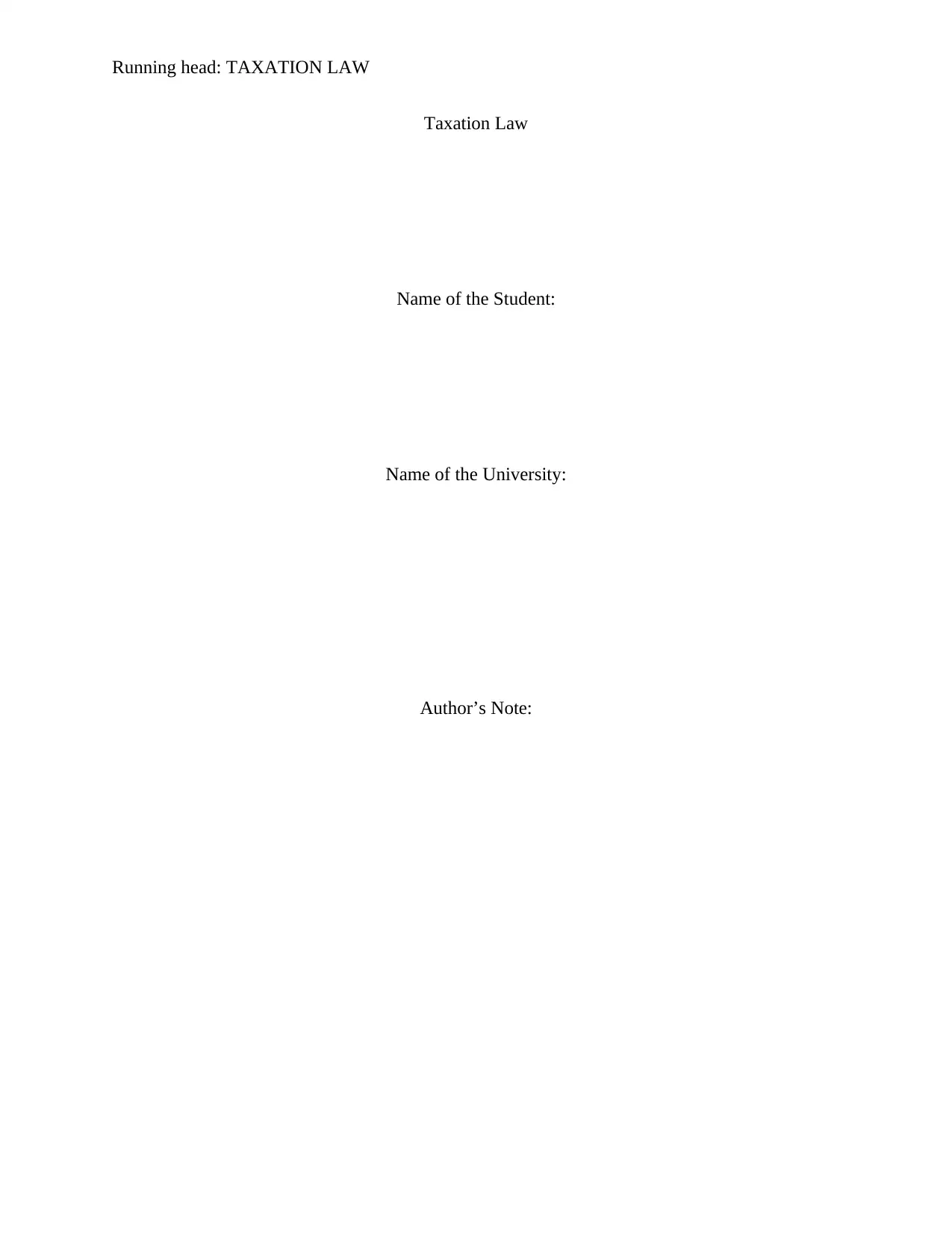
Running head: TAXATION LAW
Taxation Law
Name of the Student:
Name of the University:
Author’s Note:
Taxation Law
Name of the Student:
Name of the University:
Author’s Note:
Secure Best Marks with AI Grader
Need help grading? Try our AI Grader for instant feedback on your assignments.
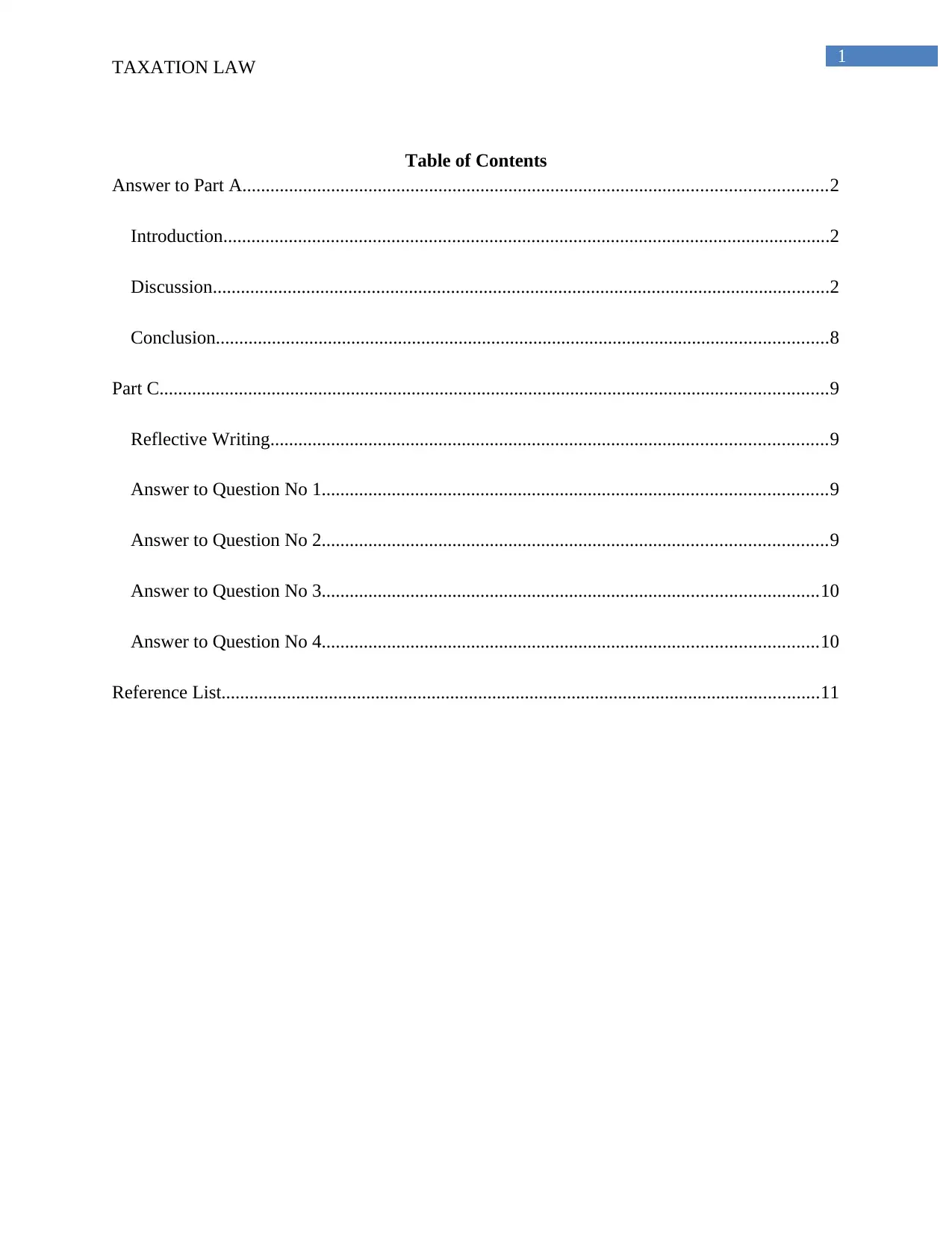
1
TAXATION LAW
Table of Contents
Answer to Part A.............................................................................................................................2
Introduction..................................................................................................................................2
Discussion....................................................................................................................................2
Conclusion...................................................................................................................................8
Part C...............................................................................................................................................9
Reflective Writing.......................................................................................................................9
Answer to Question No 1............................................................................................................9
Answer to Question No 2............................................................................................................9
Answer to Question No 3..........................................................................................................10
Answer to Question No 4..........................................................................................................10
Reference List................................................................................................................................11
TAXATION LAW
Table of Contents
Answer to Part A.............................................................................................................................2
Introduction..................................................................................................................................2
Discussion....................................................................................................................................2
Conclusion...................................................................................................................................8
Part C...............................................................................................................................................9
Reflective Writing.......................................................................................................................9
Answer to Question No 1............................................................................................................9
Answer to Question No 2............................................................................................................9
Answer to Question No 3..........................................................................................................10
Answer to Question No 4..........................................................................................................10
Reference List................................................................................................................................11
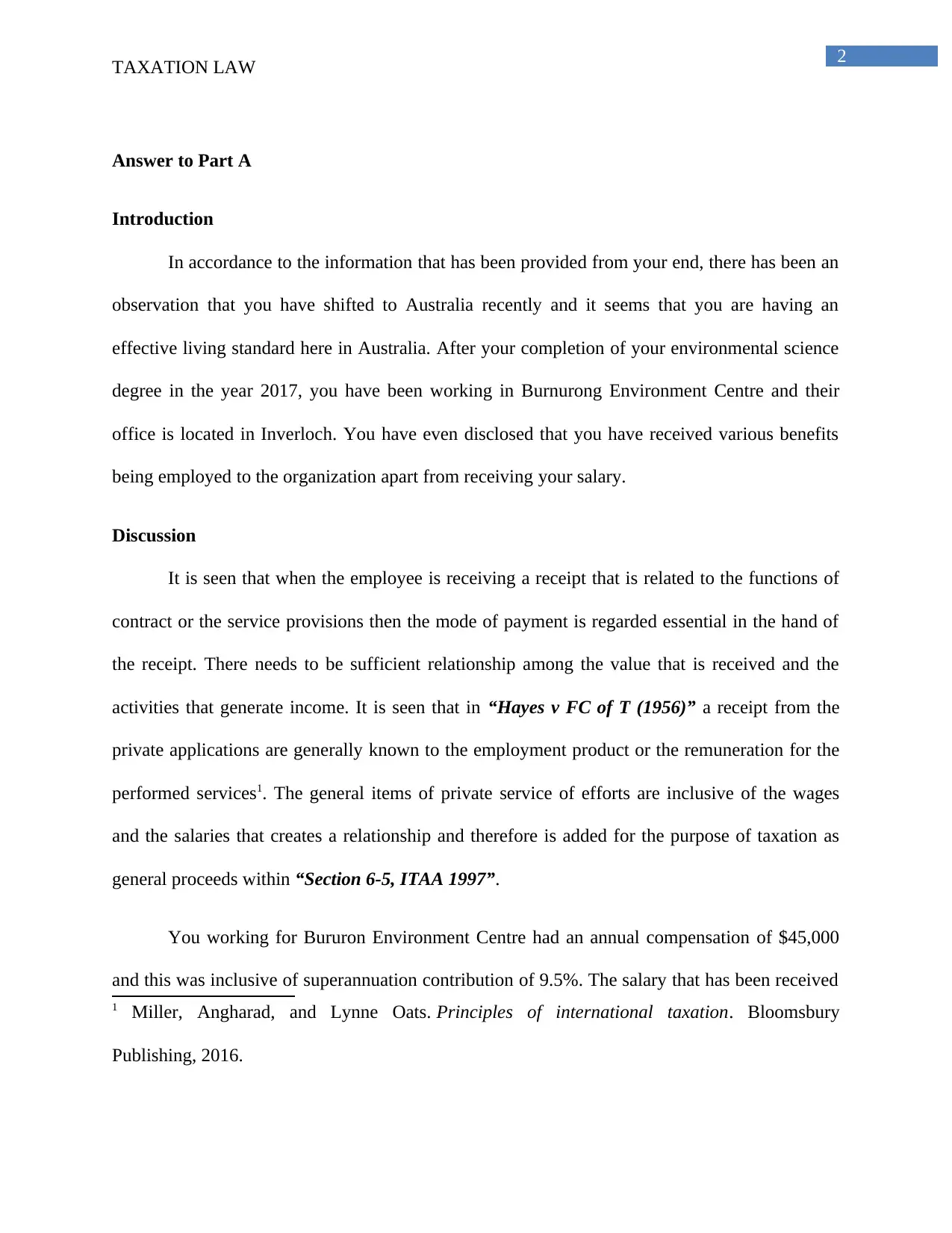
2
TAXATION LAW
Answer to Part A
Introduction
In accordance to the information that has been provided from your end, there has been an
observation that you have shifted to Australia recently and it seems that you are having an
effective living standard here in Australia. After your completion of your environmental science
degree in the year 2017, you have been working in Burnurong Environment Centre and their
office is located in Inverloch. You have even disclosed that you have received various benefits
being employed to the organization apart from receiving your salary.
Discussion
It is seen that when the employee is receiving a receipt that is related to the functions of
contract or the service provisions then the mode of payment is regarded essential in the hand of
the receipt. There needs to be sufficient relationship among the value that is received and the
activities that generate income. It is seen that in “Hayes v FC of T (1956)” a receipt from the
private applications are generally known to the employment product or the remuneration for the
performed services1. The general items of private service of efforts are inclusive of the wages
and the salaries that creates a relationship and therefore is added for the purpose of taxation as
general proceeds within “Section 6-5, ITAA 1997”.
You working for Bururon Environment Centre had an annual compensation of $45,000
and this was inclusive of superannuation contribution of 9.5%. The salary that has been received
1 Miller, Angharad, and Lynne Oats. Principles of international taxation. Bloomsbury
Publishing, 2016.
TAXATION LAW
Answer to Part A
Introduction
In accordance to the information that has been provided from your end, there has been an
observation that you have shifted to Australia recently and it seems that you are having an
effective living standard here in Australia. After your completion of your environmental science
degree in the year 2017, you have been working in Burnurong Environment Centre and their
office is located in Inverloch. You have even disclosed that you have received various benefits
being employed to the organization apart from receiving your salary.
Discussion
It is seen that when the employee is receiving a receipt that is related to the functions of
contract or the service provisions then the mode of payment is regarded essential in the hand of
the receipt. There needs to be sufficient relationship among the value that is received and the
activities that generate income. It is seen that in “Hayes v FC of T (1956)” a receipt from the
private applications are generally known to the employment product or the remuneration for the
performed services1. The general items of private service of efforts are inclusive of the wages
and the salaries that creates a relationship and therefore is added for the purpose of taxation as
general proceeds within “Section 6-5, ITAA 1997”.
You working for Bururon Environment Centre had an annual compensation of $45,000
and this was inclusive of superannuation contribution of 9.5%. The salary that has been received
1 Miller, Angharad, and Lynne Oats. Principles of international taxation. Bloomsbury
Publishing, 2016.
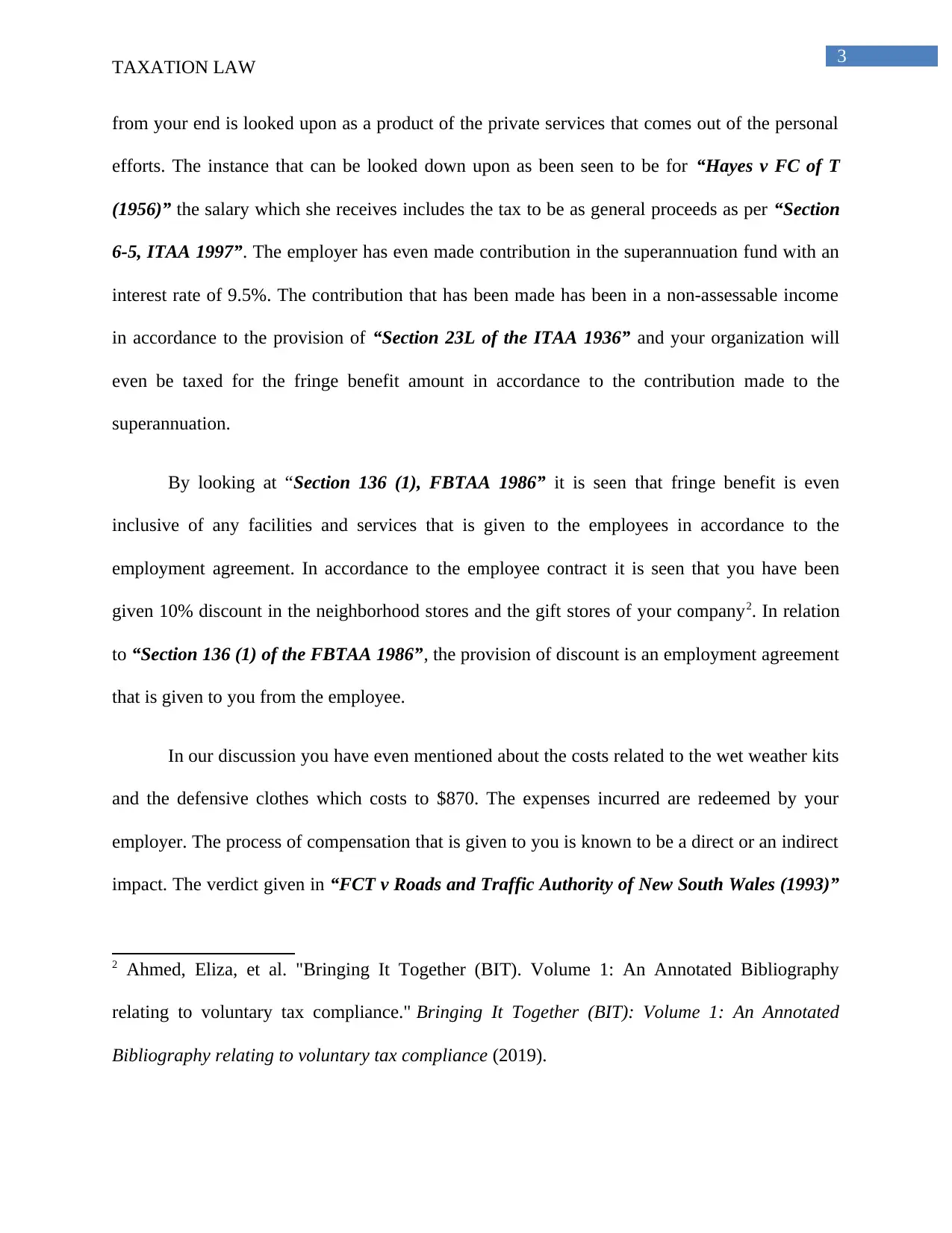
3
TAXATION LAW
from your end is looked upon as a product of the private services that comes out of the personal
efforts. The instance that can be looked down upon as been seen to be for “Hayes v FC of T
(1956)” the salary which she receives includes the tax to be as general proceeds as per “Section
6-5, ITAA 1997”. The employer has even made contribution in the superannuation fund with an
interest rate of 9.5%. The contribution that has been made has been in a non-assessable income
in accordance to the provision of “Section 23L of the ITAA 1936” and your organization will
even be taxed for the fringe benefit amount in accordance to the contribution made to the
superannuation.
By looking at “Section 136 (1), FBTAA 1986” it is seen that fringe benefit is even
inclusive of any facilities and services that is given to the employees in accordance to the
employment agreement. In accordance to the employee contract it is seen that you have been
given 10% discount in the neighborhood stores and the gift stores of your company2. In relation
to “Section 136 (1) of the FBTAA 1986”, the provision of discount is an employment agreement
that is given to you from the employee.
In our discussion you have even mentioned about the costs related to the wet weather kits
and the defensive clothes which costs to $870. The expenses incurred are redeemed by your
employer. The process of compensation that is given to you is known to be a direct or an indirect
impact. The verdict given in “FCT v Roads and Traffic Authority of New South Wales (1993)”
2 Ahmed, Eliza, et al. "Bringing It Together (BIT). Volume 1: An Annotated Bibliography
relating to voluntary tax compliance." Bringing It Together (BIT): Volume 1: An Annotated
Bibliography relating to voluntary tax compliance (2019).
TAXATION LAW
from your end is looked upon as a product of the private services that comes out of the personal
efforts. The instance that can be looked down upon as been seen to be for “Hayes v FC of T
(1956)” the salary which she receives includes the tax to be as general proceeds as per “Section
6-5, ITAA 1997”. The employer has even made contribution in the superannuation fund with an
interest rate of 9.5%. The contribution that has been made has been in a non-assessable income
in accordance to the provision of “Section 23L of the ITAA 1936” and your organization will
even be taxed for the fringe benefit amount in accordance to the contribution made to the
superannuation.
By looking at “Section 136 (1), FBTAA 1986” it is seen that fringe benefit is even
inclusive of any facilities and services that is given to the employees in accordance to the
employment agreement. In accordance to the employee contract it is seen that you have been
given 10% discount in the neighborhood stores and the gift stores of your company2. In relation
to “Section 136 (1) of the FBTAA 1986”, the provision of discount is an employment agreement
that is given to you from the employee.
In our discussion you have even mentioned about the costs related to the wet weather kits
and the defensive clothes which costs to $870. The expenses incurred are redeemed by your
employer. The process of compensation that is given to you is known to be a direct or an indirect
impact. The verdict given in “FCT v Roads and Traffic Authority of New South Wales (1993)”
2 Ahmed, Eliza, et al. "Bringing It Together (BIT). Volume 1: An Annotated Bibliography
relating to voluntary tax compliance." Bringing It Together (BIT): Volume 1: An Annotated
Bibliography relating to voluntary tax compliance (2019).
Secure Best Marks with AI Grader
Need help grading? Try our AI Grader for instant feedback on your assignments.
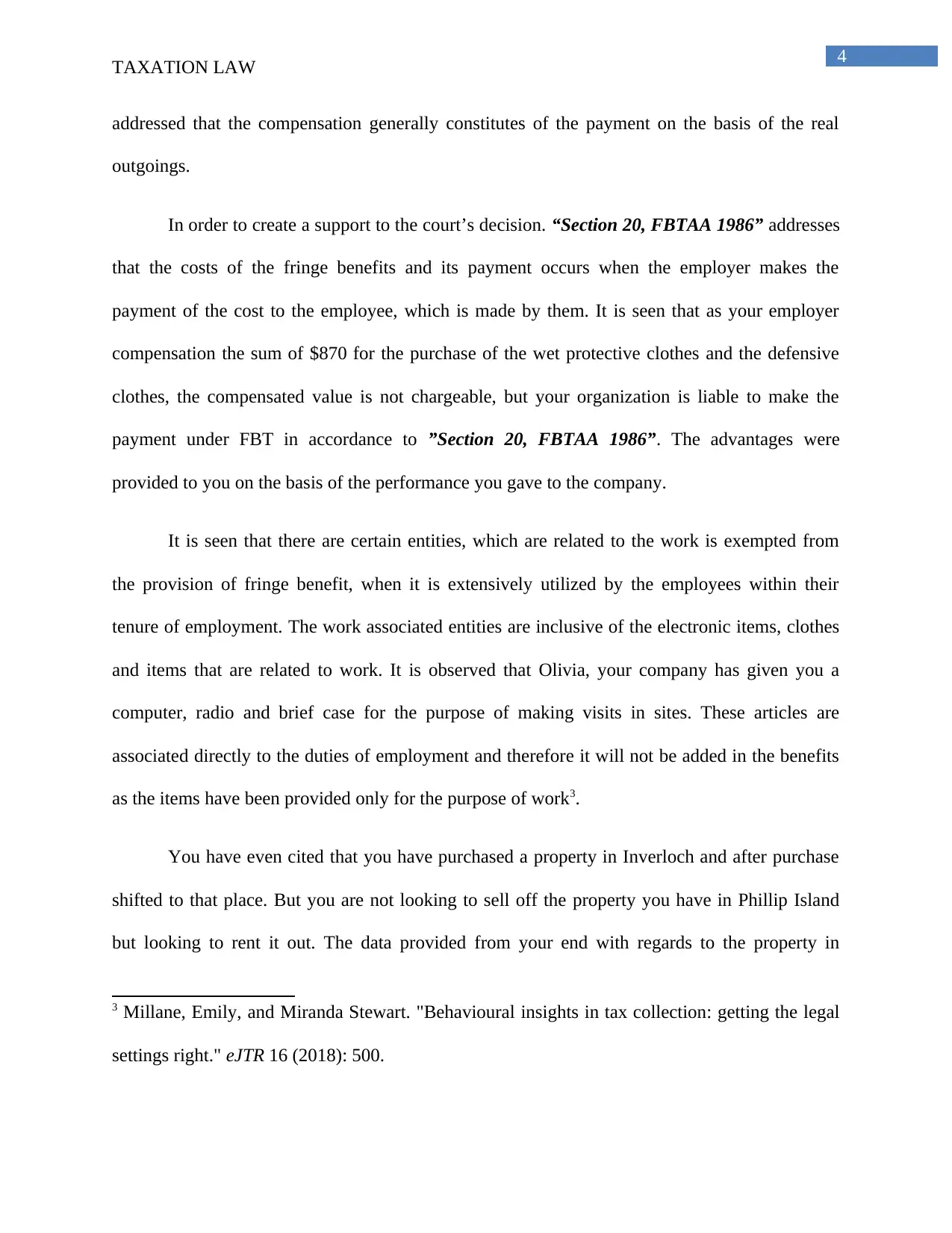
4
TAXATION LAW
addressed that the compensation generally constitutes of the payment on the basis of the real
outgoings.
In order to create a support to the court’s decision. “Section 20, FBTAA 1986” addresses
that the costs of the fringe benefits and its payment occurs when the employer makes the
payment of the cost to the employee, which is made by them. It is seen that as your employer
compensation the sum of $870 for the purchase of the wet protective clothes and the defensive
clothes, the compensated value is not chargeable, but your organization is liable to make the
payment under FBT in accordance to ”Section 20, FBTAA 1986”. The advantages were
provided to you on the basis of the performance you gave to the company.
It is seen that there are certain entities, which are related to the work is exempted from
the provision of fringe benefit, when it is extensively utilized by the employees within their
tenure of employment. The work associated entities are inclusive of the electronic items, clothes
and items that are related to work. It is observed that Olivia, your company has given you a
computer, radio and brief case for the purpose of making visits in sites. These articles are
associated directly to the duties of employment and therefore it will not be added in the benefits
as the items have been provided only for the purpose of work3.
You have even cited that you have purchased a property in Inverloch and after purchase
shifted to that place. But you are not looking to sell off the property you have in Phillip Island
but looking to rent it out. The data provided from your end with regards to the property in
3 Millane, Emily, and Miranda Stewart. "Behavioural insights in tax collection: getting the legal
settings right." eJTR 16 (2018): 500.
TAXATION LAW
addressed that the compensation generally constitutes of the payment on the basis of the real
outgoings.
In order to create a support to the court’s decision. “Section 20, FBTAA 1986” addresses
that the costs of the fringe benefits and its payment occurs when the employer makes the
payment of the cost to the employee, which is made by them. It is seen that as your employer
compensation the sum of $870 for the purchase of the wet protective clothes and the defensive
clothes, the compensated value is not chargeable, but your organization is liable to make the
payment under FBT in accordance to ”Section 20, FBTAA 1986”. The advantages were
provided to you on the basis of the performance you gave to the company.
It is seen that there are certain entities, which are related to the work is exempted from
the provision of fringe benefit, when it is extensively utilized by the employees within their
tenure of employment. The work associated entities are inclusive of the electronic items, clothes
and items that are related to work. It is observed that Olivia, your company has given you a
computer, radio and brief case for the purpose of making visits in sites. These articles are
associated directly to the duties of employment and therefore it will not be added in the benefits
as the items have been provided only for the purpose of work3.
You have even cited that you have purchased a property in Inverloch and after purchase
shifted to that place. But you are not looking to sell off the property you have in Phillip Island
but looking to rent it out. The data provided from your end with regards to the property in
3 Millane, Emily, and Miranda Stewart. "Behavioural insights in tax collection: getting the legal
settings right." eJTR 16 (2018): 500.
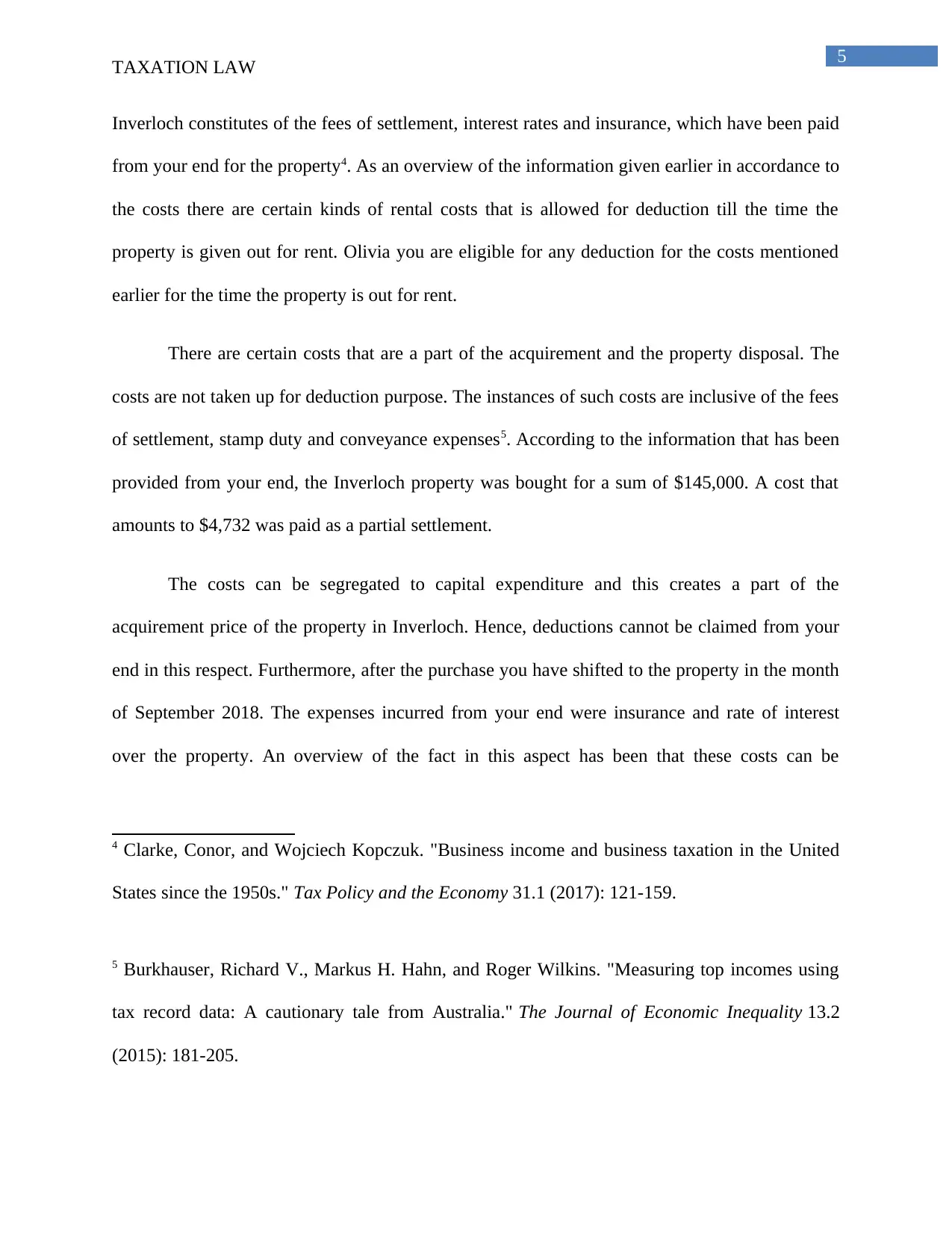
5
TAXATION LAW
Inverloch constitutes of the fees of settlement, interest rates and insurance, which have been paid
from your end for the property4. As an overview of the information given earlier in accordance to
the costs there are certain kinds of rental costs that is allowed for deduction till the time the
property is given out for rent. Olivia you are eligible for any deduction for the costs mentioned
earlier for the time the property is out for rent.
There are certain costs that are a part of the acquirement and the property disposal. The
costs are not taken up for deduction purpose. The instances of such costs are inclusive of the fees
of settlement, stamp duty and conveyance expenses5. According to the information that has been
provided from your end, the Inverloch property was bought for a sum of $145,000. A cost that
amounts to $4,732 was paid as a partial settlement.
The costs can be segregated to capital expenditure and this creates a part of the
acquirement price of the property in Inverloch. Hence, deductions cannot be claimed from your
end in this respect. Furthermore, after the purchase you have shifted to the property in the month
of September 2018. The expenses incurred from your end were insurance and rate of interest
over the property. An overview of the fact in this aspect has been that these costs can be
4 Clarke, Conor, and Wojciech Kopczuk. "Business income and business taxation in the United
States since the 1950s." Tax Policy and the Economy 31.1 (2017): 121-159.
5 Burkhauser, Richard V., Markus H. Hahn, and Roger Wilkins. "Measuring top incomes using
tax record data: A cautionary tale from Australia." The Journal of Economic Inequality 13.2
(2015): 181-205.
TAXATION LAW
Inverloch constitutes of the fees of settlement, interest rates and insurance, which have been paid
from your end for the property4. As an overview of the information given earlier in accordance to
the costs there are certain kinds of rental costs that is allowed for deduction till the time the
property is given out for rent. Olivia you are eligible for any deduction for the costs mentioned
earlier for the time the property is out for rent.
There are certain costs that are a part of the acquirement and the property disposal. The
costs are not taken up for deduction purpose. The instances of such costs are inclusive of the fees
of settlement, stamp duty and conveyance expenses5. According to the information that has been
provided from your end, the Inverloch property was bought for a sum of $145,000. A cost that
amounts to $4,732 was paid as a partial settlement.
The costs can be segregated to capital expenditure and this creates a part of the
acquirement price of the property in Inverloch. Hence, deductions cannot be claimed from your
end in this respect. Furthermore, after the purchase you have shifted to the property in the month
of September 2018. The expenses incurred from your end were insurance and rate of interest
over the property. An overview of the fact in this aspect has been that these costs can be
4 Clarke, Conor, and Wojciech Kopczuk. "Business income and business taxation in the United
States since the 1950s." Tax Policy and the Economy 31.1 (2017): 121-159.
5 Burkhauser, Richard V., Markus H. Hahn, and Roger Wilkins. "Measuring top incomes using
tax record data: A cautionary tale from Australia." The Journal of Economic Inequality 13.2
(2015): 181-205.
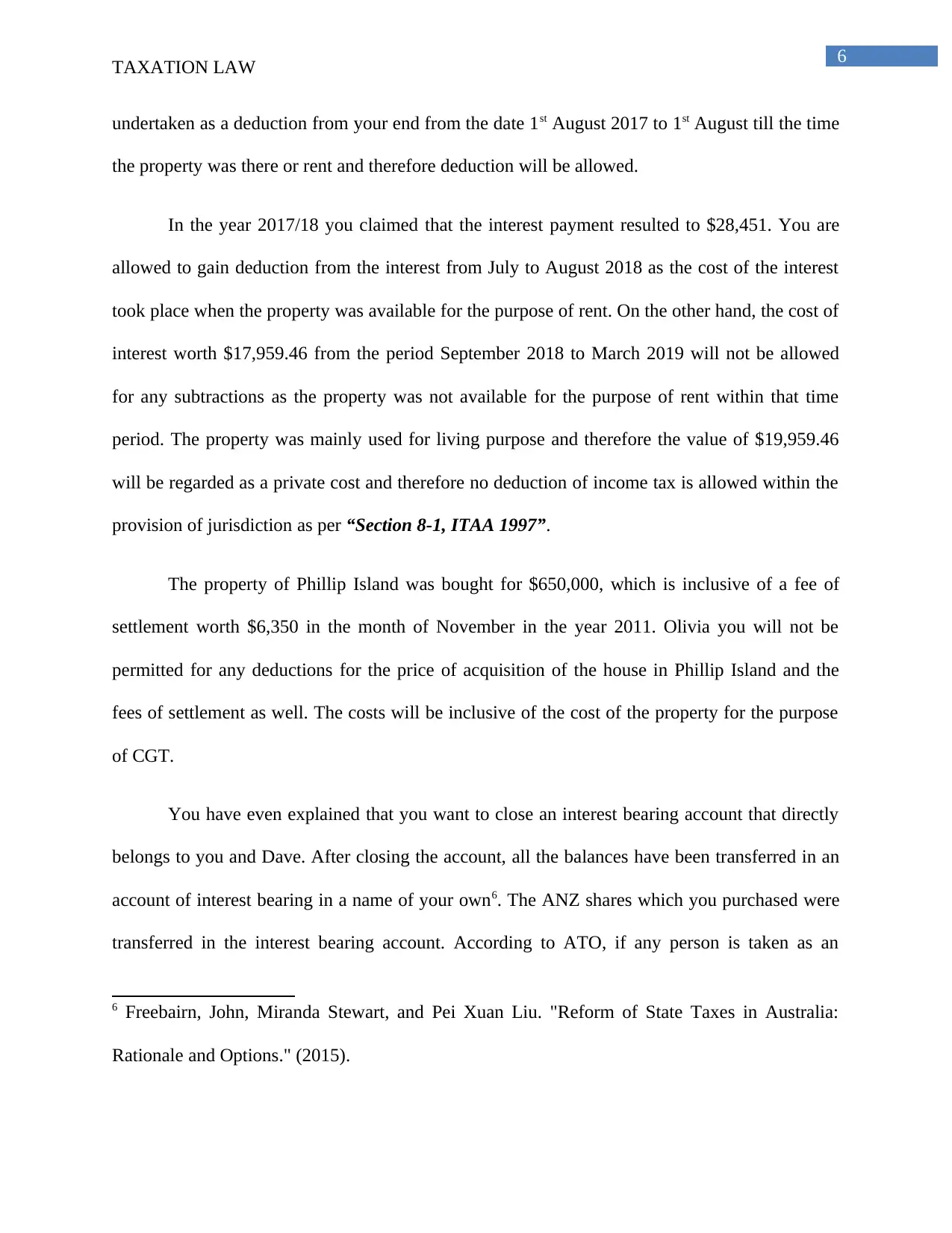
6
TAXATION LAW
undertaken as a deduction from your end from the date 1st August 2017 to 1st August till the time
the property was there or rent and therefore deduction will be allowed.
In the year 2017/18 you claimed that the interest payment resulted to $28,451. You are
allowed to gain deduction from the interest from July to August 2018 as the cost of the interest
took place when the property was available for the purpose of rent. On the other hand, the cost of
interest worth $17,959.46 from the period September 2018 to March 2019 will not be allowed
for any subtractions as the property was not available for the purpose of rent within that time
period. The property was mainly used for living purpose and therefore the value of $19,959.46
will be regarded as a private cost and therefore no deduction of income tax is allowed within the
provision of jurisdiction as per “Section 8-1, ITAA 1997”.
The property of Phillip Island was bought for $650,000, which is inclusive of a fee of
settlement worth $6,350 in the month of November in the year 2011. Olivia you will not be
permitted for any deductions for the price of acquisition of the house in Phillip Island and the
fees of settlement as well. The costs will be inclusive of the cost of the property for the purpose
of CGT.
You have even explained that you want to close an interest bearing account that directly
belongs to you and Dave. After closing the account, all the balances have been transferred in an
account of interest bearing in a name of your own6. The ANZ shares which you purchased were
transferred in the interest bearing account. According to ATO, if any person is taken as an
6 Freebairn, John, Miranda Stewart, and Pei Xuan Liu. "Reform of State Taxes in Australia:
Rationale and Options." (2015).
TAXATION LAW
undertaken as a deduction from your end from the date 1st August 2017 to 1st August till the time
the property was there or rent and therefore deduction will be allowed.
In the year 2017/18 you claimed that the interest payment resulted to $28,451. You are
allowed to gain deduction from the interest from July to August 2018 as the cost of the interest
took place when the property was available for the purpose of rent. On the other hand, the cost of
interest worth $17,959.46 from the period September 2018 to March 2019 will not be allowed
for any subtractions as the property was not available for the purpose of rent within that time
period. The property was mainly used for living purpose and therefore the value of $19,959.46
will be regarded as a private cost and therefore no deduction of income tax is allowed within the
provision of jurisdiction as per “Section 8-1, ITAA 1997”.
The property of Phillip Island was bought for $650,000, which is inclusive of a fee of
settlement worth $6,350 in the month of November in the year 2011. Olivia you will not be
permitted for any deductions for the price of acquisition of the house in Phillip Island and the
fees of settlement as well. The costs will be inclusive of the cost of the property for the purpose
of CGT.
You have even explained that you want to close an interest bearing account that directly
belongs to you and Dave. After closing the account, all the balances have been transferred in an
account of interest bearing in a name of your own6. The ANZ shares which you purchased were
transferred in the interest bearing account. According to ATO, if any person is taken as an
6 Freebairn, John, Miranda Stewart, and Pei Xuan Liu. "Reform of State Taxes in Australia:
Rationale and Options." (2015).
Paraphrase This Document
Need a fresh take? Get an instant paraphrase of this document with our AI Paraphraser
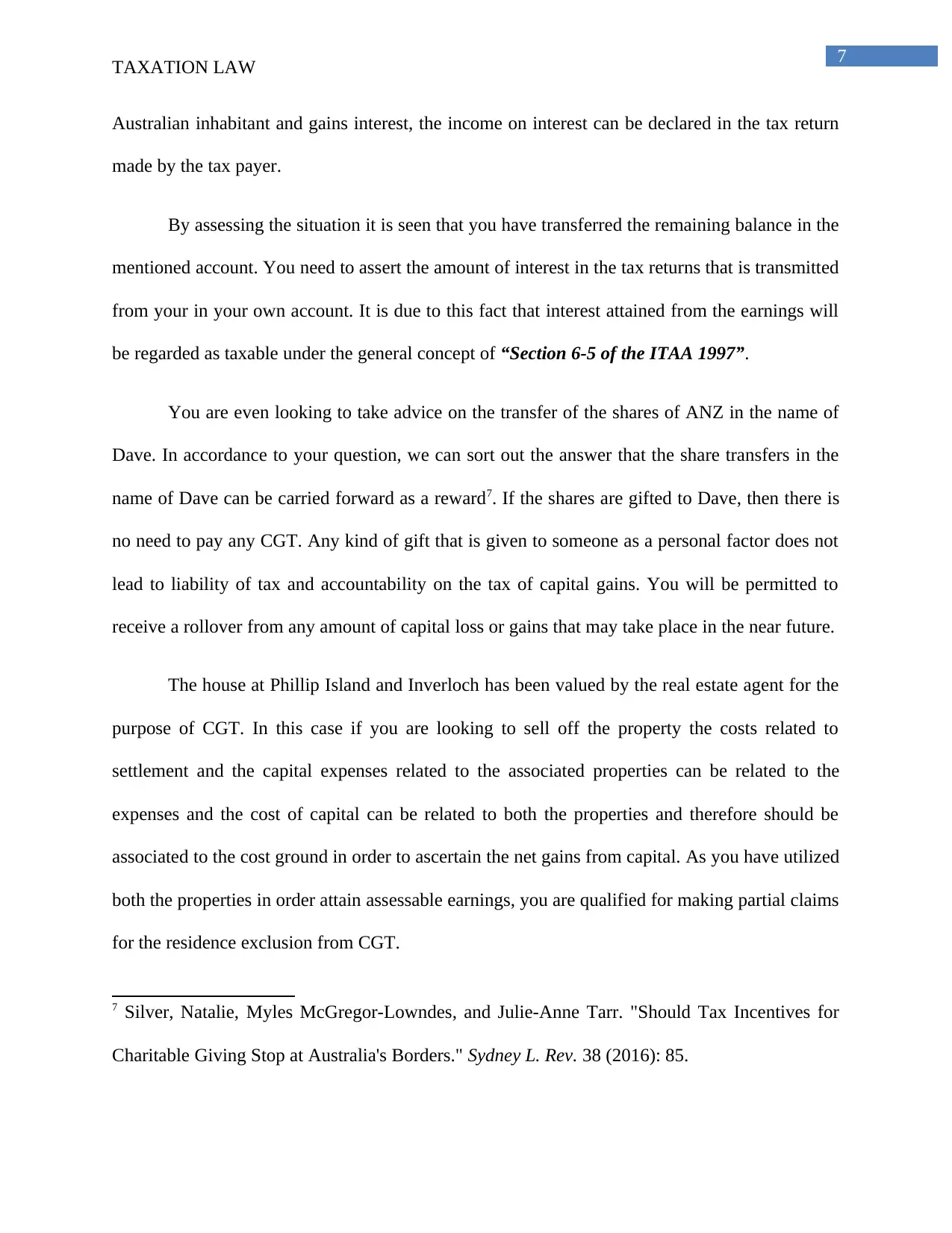
7
TAXATION LAW
Australian inhabitant and gains interest, the income on interest can be declared in the tax return
made by the tax payer.
By assessing the situation it is seen that you have transferred the remaining balance in the
mentioned account. You need to assert the amount of interest in the tax returns that is transmitted
from your in your own account. It is due to this fact that interest attained from the earnings will
be regarded as taxable under the general concept of “Section 6-5 of the ITAA 1997”.
You are even looking to take advice on the transfer of the shares of ANZ in the name of
Dave. In accordance to your question, we can sort out the answer that the share transfers in the
name of Dave can be carried forward as a reward7. If the shares are gifted to Dave, then there is
no need to pay any CGT. Any kind of gift that is given to someone as a personal factor does not
lead to liability of tax and accountability on the tax of capital gains. You will be permitted to
receive a rollover from any amount of capital loss or gains that may take place in the near future.
The house at Phillip Island and Inverloch has been valued by the real estate agent for the
purpose of CGT. In this case if you are looking to sell off the property the costs related to
settlement and the capital expenses related to the associated properties can be related to the
expenses and the cost of capital can be related to both the properties and therefore should be
associated to the cost ground in order to ascertain the net gains from capital. As you have utilized
both the properties in order attain assessable earnings, you are qualified for making partial claims
for the residence exclusion from CGT.
7 Silver, Natalie, Myles McGregor-Lowndes, and Julie-Anne Tarr. "Should Tax Incentives for
Charitable Giving Stop at Australia's Borders." Sydney L. Rev. 38 (2016): 85.
TAXATION LAW
Australian inhabitant and gains interest, the income on interest can be declared in the tax return
made by the tax payer.
By assessing the situation it is seen that you have transferred the remaining balance in the
mentioned account. You need to assert the amount of interest in the tax returns that is transmitted
from your in your own account. It is due to this fact that interest attained from the earnings will
be regarded as taxable under the general concept of “Section 6-5 of the ITAA 1997”.
You are even looking to take advice on the transfer of the shares of ANZ in the name of
Dave. In accordance to your question, we can sort out the answer that the share transfers in the
name of Dave can be carried forward as a reward7. If the shares are gifted to Dave, then there is
no need to pay any CGT. Any kind of gift that is given to someone as a personal factor does not
lead to liability of tax and accountability on the tax of capital gains. You will be permitted to
receive a rollover from any amount of capital loss or gains that may take place in the near future.
The house at Phillip Island and Inverloch has been valued by the real estate agent for the
purpose of CGT. In this case if you are looking to sell off the property the costs related to
settlement and the capital expenses related to the associated properties can be related to the
expenses and the cost of capital can be related to both the properties and therefore should be
associated to the cost ground in order to ascertain the net gains from capital. As you have utilized
both the properties in order attain assessable earnings, you are qualified for making partial claims
for the residence exclusion from CGT.
7 Silver, Natalie, Myles McGregor-Lowndes, and Julie-Anne Tarr. "Should Tax Incentives for
Charitable Giving Stop at Australia's Borders." Sydney L. Rev. 38 (2016): 85.
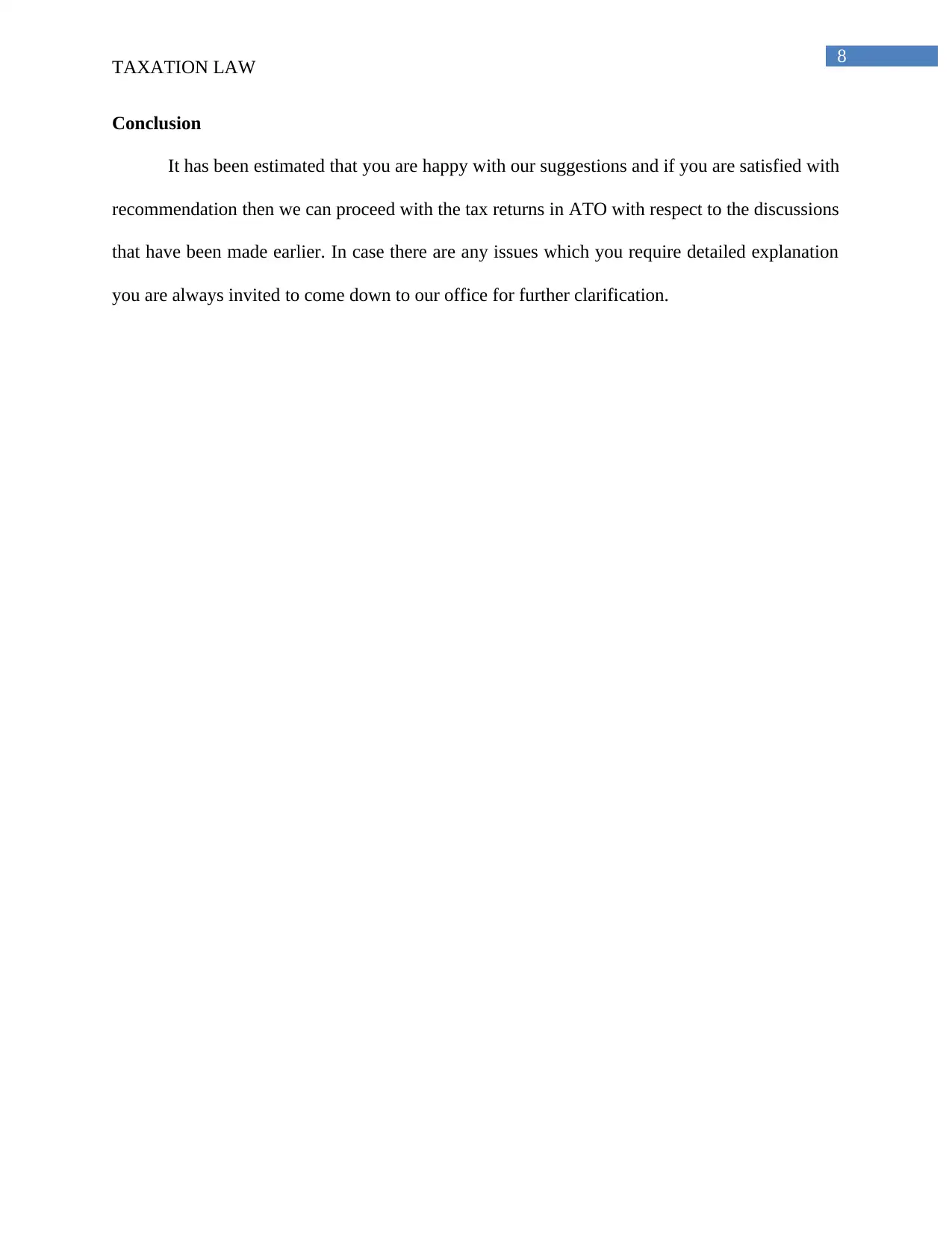
8
TAXATION LAW
Conclusion
It has been estimated that you are happy with our suggestions and if you are satisfied with
recommendation then we can proceed with the tax returns in ATO with respect to the discussions
that have been made earlier. In case there are any issues which you require detailed explanation
you are always invited to come down to our office for further clarification.
TAXATION LAW
Conclusion
It has been estimated that you are happy with our suggestions and if you are satisfied with
recommendation then we can proceed with the tax returns in ATO with respect to the discussions
that have been made earlier. In case there are any issues which you require detailed explanation
you are always invited to come down to our office for further clarification.
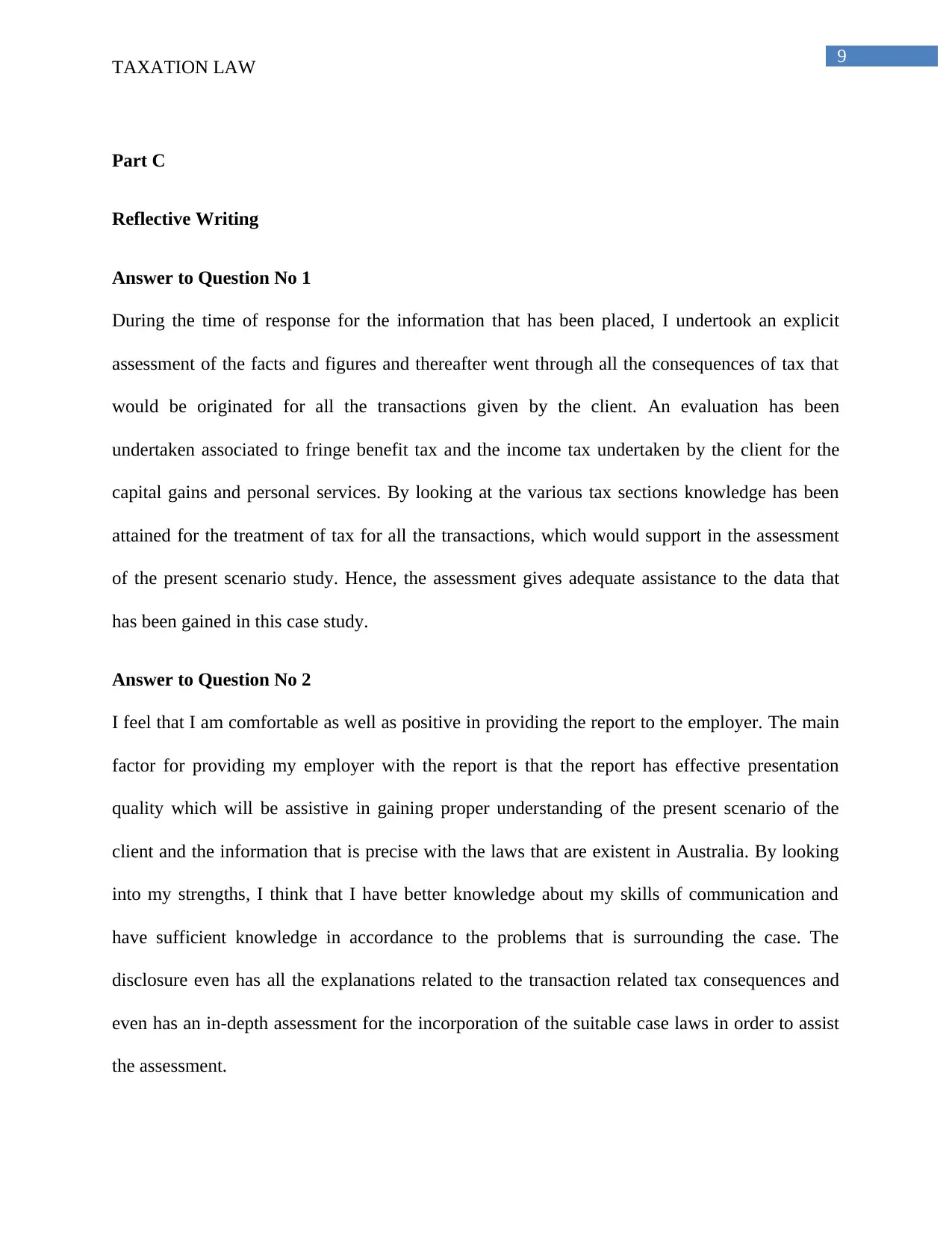
9
TAXATION LAW
Part C
Reflective Writing
Answer to Question No 1
During the time of response for the information that has been placed, I undertook an explicit
assessment of the facts and figures and thereafter went through all the consequences of tax that
would be originated for all the transactions given by the client. An evaluation has been
undertaken associated to fringe benefit tax and the income tax undertaken by the client for the
capital gains and personal services. By looking at the various tax sections knowledge has been
attained for the treatment of tax for all the transactions, which would support in the assessment
of the present scenario study. Hence, the assessment gives adequate assistance to the data that
has been gained in this case study.
Answer to Question No 2
I feel that I am comfortable as well as positive in providing the report to the employer. The main
factor for providing my employer with the report is that the report has effective presentation
quality which will be assistive in gaining proper understanding of the present scenario of the
client and the information that is precise with the laws that are existent in Australia. By looking
into my strengths, I think that I have better knowledge about my skills of communication and
have sufficient knowledge in accordance to the problems that is surrounding the case. The
disclosure even has all the explanations related to the transaction related tax consequences and
even has an in-depth assessment for the incorporation of the suitable case laws in order to assist
the assessment.
TAXATION LAW
Part C
Reflective Writing
Answer to Question No 1
During the time of response for the information that has been placed, I undertook an explicit
assessment of the facts and figures and thereafter went through all the consequences of tax that
would be originated for all the transactions given by the client. An evaluation has been
undertaken associated to fringe benefit tax and the income tax undertaken by the client for the
capital gains and personal services. By looking at the various tax sections knowledge has been
attained for the treatment of tax for all the transactions, which would support in the assessment
of the present scenario study. Hence, the assessment gives adequate assistance to the data that
has been gained in this case study.
Answer to Question No 2
I feel that I am comfortable as well as positive in providing the report to the employer. The main
factor for providing my employer with the report is that the report has effective presentation
quality which will be assistive in gaining proper understanding of the present scenario of the
client and the information that is precise with the laws that are existent in Australia. By looking
into my strengths, I think that I have better knowledge about my skills of communication and
have sufficient knowledge in accordance to the problems that is surrounding the case. The
disclosure even has all the explanations related to the transaction related tax consequences and
even has an in-depth assessment for the incorporation of the suitable case laws in order to assist
the assessment.
Secure Best Marks with AI Grader
Need help grading? Try our AI Grader for instant feedback on your assignments.
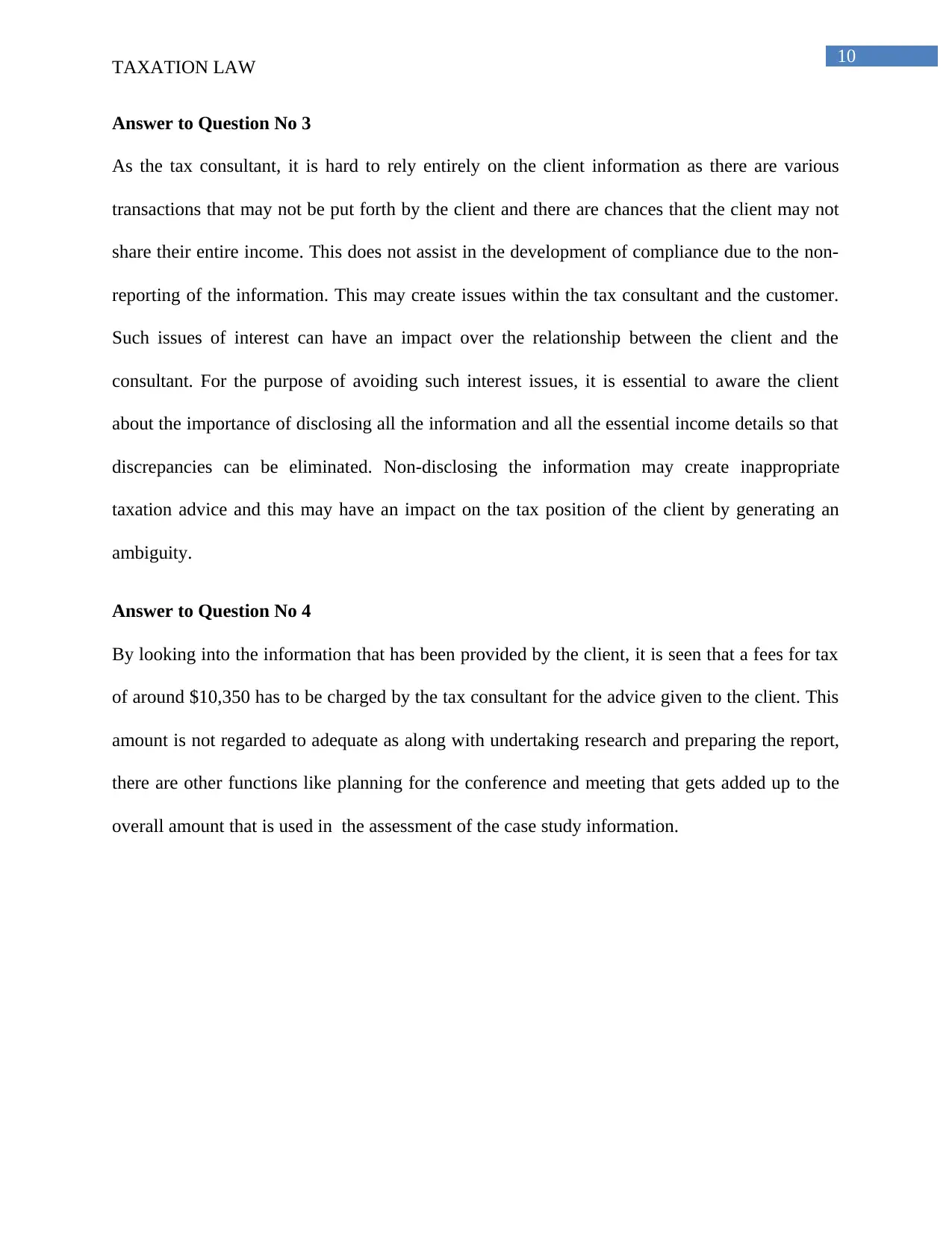
10
TAXATION LAW
Answer to Question No 3
As the tax consultant, it is hard to rely entirely on the client information as there are various
transactions that may not be put forth by the client and there are chances that the client may not
share their entire income. This does not assist in the development of compliance due to the non-
reporting of the information. This may create issues within the tax consultant and the customer.
Such issues of interest can have an impact over the relationship between the client and the
consultant. For the purpose of avoiding such interest issues, it is essential to aware the client
about the importance of disclosing all the information and all the essential income details so that
discrepancies can be eliminated. Non-disclosing the information may create inappropriate
taxation advice and this may have an impact on the tax position of the client by generating an
ambiguity.
Answer to Question No 4
By looking into the information that has been provided by the client, it is seen that a fees for tax
of around $10,350 has to be charged by the tax consultant for the advice given to the client. This
amount is not regarded to adequate as along with undertaking research and preparing the report,
there are other functions like planning for the conference and meeting that gets added up to the
overall amount that is used in the assessment of the case study information.
TAXATION LAW
Answer to Question No 3
As the tax consultant, it is hard to rely entirely on the client information as there are various
transactions that may not be put forth by the client and there are chances that the client may not
share their entire income. This does not assist in the development of compliance due to the non-
reporting of the information. This may create issues within the tax consultant and the customer.
Such issues of interest can have an impact over the relationship between the client and the
consultant. For the purpose of avoiding such interest issues, it is essential to aware the client
about the importance of disclosing all the information and all the essential income details so that
discrepancies can be eliminated. Non-disclosing the information may create inappropriate
taxation advice and this may have an impact on the tax position of the client by generating an
ambiguity.
Answer to Question No 4
By looking into the information that has been provided by the client, it is seen that a fees for tax
of around $10,350 has to be charged by the tax consultant for the advice given to the client. This
amount is not regarded to adequate as along with undertaking research and preparing the report,
there are other functions like planning for the conference and meeting that gets added up to the
overall amount that is used in the assessment of the case study information.
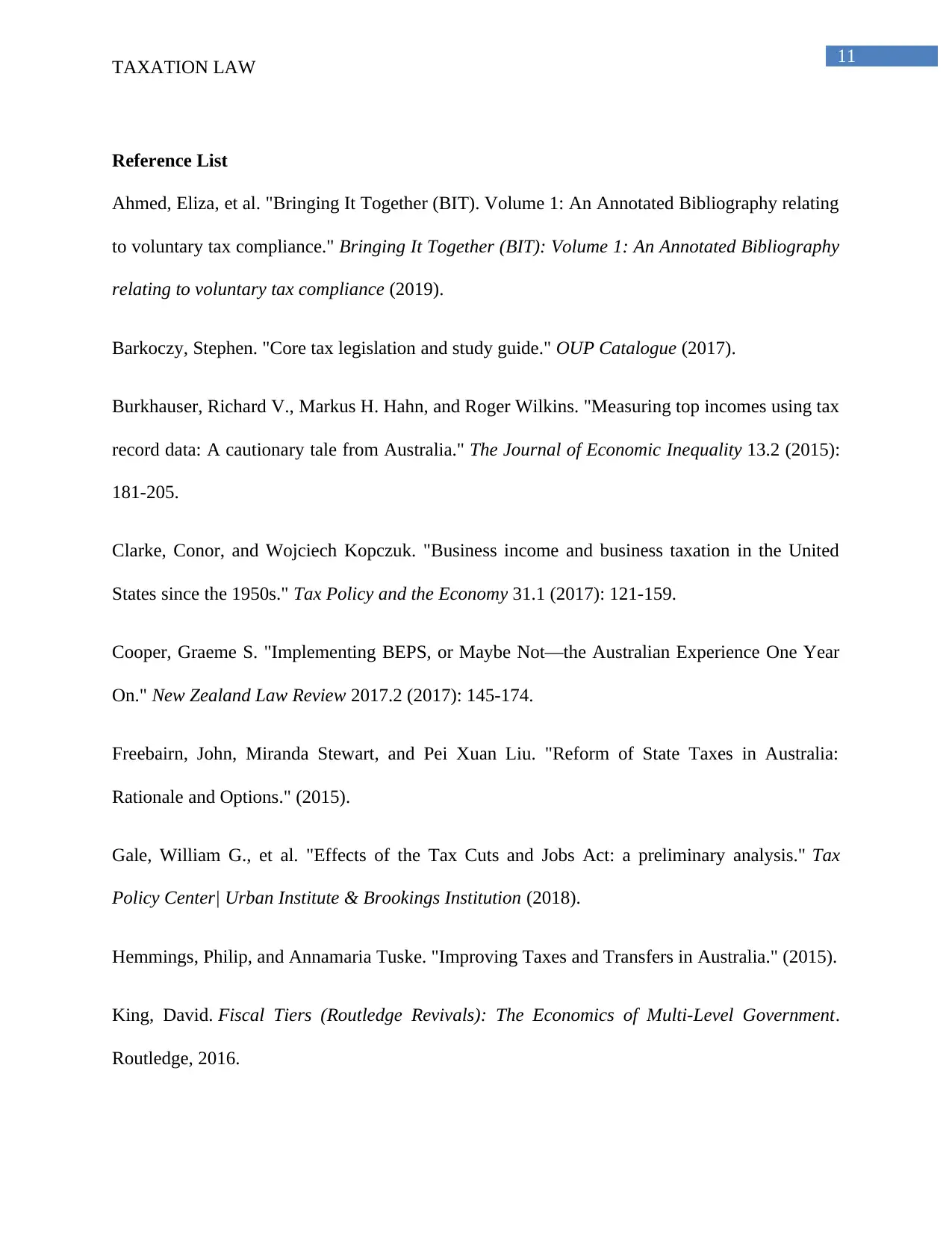
11
TAXATION LAW
Reference List
Ahmed, Eliza, et al. "Bringing It Together (BIT). Volume 1: An Annotated Bibliography relating
to voluntary tax compliance." Bringing It Together (BIT): Volume 1: An Annotated Bibliography
relating to voluntary tax compliance (2019).
Barkoczy, Stephen. "Core tax legislation and study guide." OUP Catalogue (2017).
Burkhauser, Richard V., Markus H. Hahn, and Roger Wilkins. "Measuring top incomes using tax
record data: A cautionary tale from Australia." The Journal of Economic Inequality 13.2 (2015):
181-205.
Clarke, Conor, and Wojciech Kopczuk. "Business income and business taxation in the United
States since the 1950s." Tax Policy and the Economy 31.1 (2017): 121-159.
Cooper, Graeme S. "Implementing BEPS, or Maybe Not—the Australian Experience One Year
On." New Zealand Law Review 2017.2 (2017): 145-174.
Freebairn, John, Miranda Stewart, and Pei Xuan Liu. "Reform of State Taxes in Australia:
Rationale and Options." (2015).
Gale, William G., et al. "Effects of the Tax Cuts and Jobs Act: a preliminary analysis." Tax
Policy Center| Urban Institute & Brookings Institution (2018).
Hemmings, Philip, and Annamaria Tuske. "Improving Taxes and Transfers in Australia." (2015).
King, David. Fiscal Tiers (Routledge Revivals): The Economics of Multi-Level Government.
Routledge, 2016.
TAXATION LAW
Reference List
Ahmed, Eliza, et al. "Bringing It Together (BIT). Volume 1: An Annotated Bibliography relating
to voluntary tax compliance." Bringing It Together (BIT): Volume 1: An Annotated Bibliography
relating to voluntary tax compliance (2019).
Barkoczy, Stephen. "Core tax legislation and study guide." OUP Catalogue (2017).
Burkhauser, Richard V., Markus H. Hahn, and Roger Wilkins. "Measuring top incomes using tax
record data: A cautionary tale from Australia." The Journal of Economic Inequality 13.2 (2015):
181-205.
Clarke, Conor, and Wojciech Kopczuk. "Business income and business taxation in the United
States since the 1950s." Tax Policy and the Economy 31.1 (2017): 121-159.
Cooper, Graeme S. "Implementing BEPS, or Maybe Not—the Australian Experience One Year
On." New Zealand Law Review 2017.2 (2017): 145-174.
Freebairn, John, Miranda Stewart, and Pei Xuan Liu. "Reform of State Taxes in Australia:
Rationale and Options." (2015).
Gale, William G., et al. "Effects of the Tax Cuts and Jobs Act: a preliminary analysis." Tax
Policy Center| Urban Institute & Brookings Institution (2018).
Hemmings, Philip, and Annamaria Tuske. "Improving Taxes and Transfers in Australia." (2015).
King, David. Fiscal Tiers (Routledge Revivals): The Economics of Multi-Level Government.
Routledge, 2016.

12
TAXATION LAW
Maurer, Ludmilla, et al. "A Brave New Post-BEPS World: New Double Tax Treaty Between
Germany and Australia Implements BEPS Measures." Intertax 45.4 (2017): 310-321.
Millane, Emily, and Miranda Stewart. "Behavioural insights in tax collection: getting the legal
settings right." eJTR 16 (2018): 500.
Miller, Angharad, and Lynne Oats. Principles of international taxation. Bloomsbury Publishing,
2016.
Parker, Hermione. Instead of the Dole: an enquiry into integration of the tax and benefit systems.
Routledge, 2018.
Richardson, Grant, Grantley Taylor, and Roman Lanis. "The impact of financial distress on
corporate tax avoidance spanning the global financial crisis: Evidence from
Australia." Economic Modelling 44 (2015): 44-53.
Silver, Natalie, Myles McGregor-Lowndes, and Julie-Anne Tarr. "Should Tax Incentives for
Charitable Giving Stop at Australia's Borders." Sydney L. Rev. 38 (2016): 85.
Tran-Nam, Binh. "Tax Reform and Tax Simplification: Conceptual and Measurement Issues and
Australian Experiences." The Complexity of Tax Simplification. Palgrave Macmillan, London,
2016. 11-44.
Woellner, Robin, et al. "Australian Taxation Law 2016." OUP Catalogue (2016).
TAXATION LAW
Maurer, Ludmilla, et al. "A Brave New Post-BEPS World: New Double Tax Treaty Between
Germany and Australia Implements BEPS Measures." Intertax 45.4 (2017): 310-321.
Millane, Emily, and Miranda Stewart. "Behavioural insights in tax collection: getting the legal
settings right." eJTR 16 (2018): 500.
Miller, Angharad, and Lynne Oats. Principles of international taxation. Bloomsbury Publishing,
2016.
Parker, Hermione. Instead of the Dole: an enquiry into integration of the tax and benefit systems.
Routledge, 2018.
Richardson, Grant, Grantley Taylor, and Roman Lanis. "The impact of financial distress on
corporate tax avoidance spanning the global financial crisis: Evidence from
Australia." Economic Modelling 44 (2015): 44-53.
Silver, Natalie, Myles McGregor-Lowndes, and Julie-Anne Tarr. "Should Tax Incentives for
Charitable Giving Stop at Australia's Borders." Sydney L. Rev. 38 (2016): 85.
Tran-Nam, Binh. "Tax Reform and Tax Simplification: Conceptual and Measurement Issues and
Australian Experiences." The Complexity of Tax Simplification. Palgrave Macmillan, London,
2016. 11-44.
Woellner, Robin, et al. "Australian Taxation Law 2016." OUP Catalogue (2016).
1 out of 13
Related Documents
Your All-in-One AI-Powered Toolkit for Academic Success.
+13062052269
info@desklib.com
Available 24*7 on WhatsApp / Email
![[object Object]](/_next/static/media/star-bottom.7253800d.svg)
Unlock your academic potential
© 2024 | Zucol Services PVT LTD | All rights reserved.





